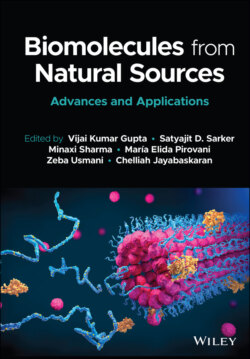Читать книгу Biomolecules from Natural Sources - Группа авторов - Страница 25
1.5.1 Carbon Source
ОглавлениеThe growth of the microorganisms for trehalose lipid production requires a carbon source. This carbon source influences not only the quantity but also the quality of the formed trehalose lipids. When carbon sources and insoluble substrates are combined the intracellular diffusion and production of different substances are simplified (Santos et al. 2016). For instance, in 1996 a study (Espuny et al. 1996) proceeded to test the effect of different carbon sources where two different mixtures were used, P-120 and P-147. P-120 was composed of n-decane, n-undecane, dodecane, n-tridecane, n-tetradecane. The second mixture, P-147, had in its composition n-tetradecane, n-pentadecane, n-hexadecane, n-heptadecane. In this study, the higher yield was accomplished using n-tridecane alone (Espuny et al. 1996).
In several studies, n-hexane was used as the carbon source (Christova et al. 2015; Janek et al. 2018; Kuyukina et al. 2016; Tokumoto et al. 2009). Another study showed that Rhodococcus erithropolis, using n-hexane as the carbon source was able to produce mono- and di-succinyl trehalose lipids (Kitamoto et al. 2002; Uchida et al. 1989).
Kuyukina et al. (2015) used as the carbon source, n-dodecane and n-hexadecane and obtained 6.5 and 9.4 g L-1 of trehalose lipids, showing that the best method uses hydrocarbons in the bioprocess. Rhodococcus wratislaviensis BN38 grown in n-hexadecane produced 3.1 g L-1 of 2,3,4,2′-trehalose tetraesters containing succinic acid. These trehalose lipids showed high surface activity reducing the surface tension to 28.6 mN m-1 in mixture and 24.4 mN m-1 when purified at a CMC value of 5 mg L-1.
In a different study, Marqués et al. (2009) carried out a study with Rhodococcus erythropolis 51T7 in a medium containing 2% of tetradecane, enabled the production of trehalose tetraester in a concentration of 0.48–1.12 g L-1 and a reduction in the surface tension to 27.9 mN m-1 at a CMC value of 37 mg L-1.
Nevertheless, other sources have been used such as n-alkanes (Inaba et al. 2013), which have been used for the production of TL-1 and TL-2, and n-decane to produce trehalose-tetraesters (Kitamoto et al. 2002), glucose or vegetable oil (Santos et al. 2016), glyceryltrioleate (Kügler et al. 2014).
Furthermore, using sugars as carbon sources directly may affect the carbohydrate moiety of trehalose lipids, which might have a good effect on the production and be less expensive.
Different carbon sources, like glycerol, diesel oil, and vegetable oil, showed feasibility as trehalose lipids producers (Bajaj et al. 2014). Additionally the authors (Bajaj et al. 2014) correlated the possibility of using trehalose lipid bioproducers as potential agents in bioremediation process.
A further target for production is the use of low-cost substrates. Experiments on R. erythropolis 16 LM.USTHB showed the conversion of used sunflower frying oil, a cheap renewable source, into extracellular glycolipids with the ability to lower the surface tension of crude broth to 31 mN m-1 (23 Franzetti et al. 2010).
Kügler et al. (2014) performed a study using non-pathogenic actinomycetes Tsukamurella spumae and Tsukamurella pseudospumae using sunflower oil as the carbon source in a fermentation medium. They found trehalose lipids with C4–C6 and C16–C18 short acyl chains in hydrophobic moiety, in a low concentration of product (approximately 1.3 g L-1). Kundu et al. (2013) performed a study using the Rhodococcus pyridinivorans NT2 strain isolated from effluent sediment contaminated with pesticides and evaluated it for biodegradation of 4-nitrotoluene. The biosurfactant produced, a trehalose lipid, exhibited surface activity, which allowed the reduction of surface tension of the media from 71 to 29 mN m-1, with a CMC value of the 30 mg L-1. The most abundant trehalose lipid derivatives produced by the mentioned strain were trehalose-succinic acids and 2,3,4,2′-trehalose tetraester analogues. Moreover, an emulsification index of 90–95% was obtained with long-chain hydrocarbons (diesel, liquid paraffin, motor oil, groundnut oil, and soybean oil) while shorter-chain alkanes resulted in a lower emulsification index (50–80%). The microbial characteristics of Rhodococcus pyridinivorans NT2 contributed to its potential use in bioremediation field, despite the low concentration in the production of trehalose lipids (45 mg L-1) (Kundu et al. 2016a, 2016b).
